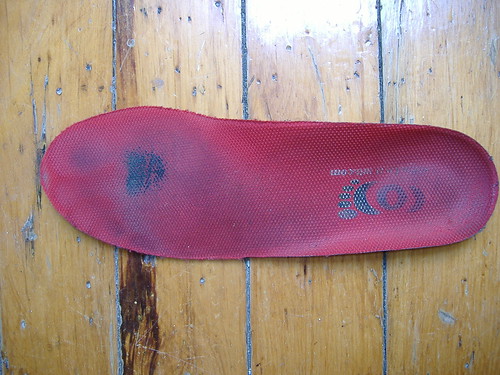 Plantar fasciitis is another orthopedic condition that accounts for a significant number of clinician visits. Approximately 10% of the United States population experiences bouts of heel pain, and these episodes result in 600,000 visits annually to medical professionals for treatment of plantar fasciitis. Riddle and Schappert (2004) noted that this problem accounts for 1% of all patient visits to orthopedic surgeons.
Plantar fasciitis is another orthopedic condition that accounts for a significant number of clinician visits. Approximately 10% of the United States population experiences bouts of heel pain, and these episodes result in 600,000 visits annually to medical professionals for treatment of plantar fasciitis. Riddle and Schappert (2004) noted that this problem accounts for 1% of all patient visits to orthopedic surgeons.
It is also yet another orthopedic condition that has countless treatments that are known to be not only no better than nature, but are counter-intuitive in the process. It is a condition that clinicians continue to over-treat. This makes it another one of those conditions that I would call “the gift that keeps on giving” – because clinicians continued to be reimbursed for treating it, regardless of the scientific literature.
What is the plantar fascia? Are the most commonly-used treatments of any benefit?
The plantar fascia is a broad structure consisting of connective tissue (collagen) that runs across the base of the foot from the calcaneus to the proximal phalanges of the toes. It contributes to the structural integrity of the medial arch of the foot, as well as increasing the leverage of the foot while toeing off during the gait cycle.
The term “plantar fasciitis” has a literal translation of “inflammation of the plantar fascia”. Most cases of “plantar fasciitis” are not truly inflammatory in nature. They might be better termed plantar fasciiopathies, much like tendinopathies that exist in the Achilles and patellar tendons. Many cases of “tendinopathy” are mistakenly classified as “tendonitis”, even thought a true inflammatory component does not exist.
Using this terminology makes sense functionally as well. The plantar fascia behaves much like an extension of the Achilles tendon. It helps to transfer loads from the Achilles to the foot and to maintain the structural rigidity of the medial arch while doing so.
With these factors in mind, it would make sense that treatment approaches (for a plantar fasciiopathy) would focus on increasing the mechanical loading capacity of the structure in question. This would involve progressive loading of the structure, with sufficient recovery built in to allow for tissue adaptations to occur. It would also progress to eccentric loading and would demand modifications to training activities. Sounds pretty simple, yes?
Sadly, this isn’t the case with most treatment options. You will hear tales of patients being told to massage the plantar fascia, use a foam roller on it, roll a frozen bottle over it, tape it, use a walking boot, use a night splint, get some over-the-counter shoe inserts or custom orthotics, change footwear … the list goes on. Many clinicians will use a variety of modalities to “decrease inflammation” and soft tissue treatments such as ART or Airrosti to “loosen” the tissues. Riddle and Schappert (2004) note that pain medication (including non-steroidal anti-inflammatories) was the most frequently used intervention (47% of patient visits).
These treatments are not attempting to increase the mechanical loading capacity of the plantar fascia. If anything, they are actually decreasing the mechanical loading capacity of the plantar fascia.
As a specific example, thousands of dollars are spent on custom orthotics to treat plantar fasciitis. These are made specifically to control motion of the foot. But the Cochrane Collaboration review reports that “for people diagnosed with plantar fasciitis (heel pain), custom foot orthoses ….
“May not reduce foot pain after 3 or 12 months any more than using fake foot orthoses …
“May not reduce foot pain after 6 weeks or 3 months any more than using night splints to hold your feet in a stretched position while you sleep …
“May not reduce foot pain after 2-3 months or 1 year any more than non-custom foot orthoses …
“May not reduce foot pain after 6-8 weeks when used along with a program of stretching exercises or night splints …
“May not reduce foot pain after 2 weeks any more than a combined treatment of manipulation, mobilisation and stretching.”
Perhaps the biggest issue of all is that patients speak of plantar fasciitis as though it is a death sentence. “I had a friend that had this for two years before it went away”, they will tell you. But when the traditional treatment approaches actually slow down the process of tissue repair and remodeling, and when a clinician can do just about anything for heel pain and get paid for it, we have a significant consumer problem. Buyer beware.
References: Riddle DL, Schappert SM. Volume of ambulatory care visits and patterns of care for patients diagnosed with plantar fasciitis: a national study of medical doctors. Foot Ankle Int. May 2004;25(5):303-10.
Photo credits: Patrick McEvoy-Halston

 "Running Injuries: Etiology And Recovery- Based Treatment" (co-author Bridget Clark, PT) appears in the third edition and fourth editions of "Clinical Orthopaedic Rehabilitation: A Team Approach" by Charles Giangarra, MD and Robert C. Manske, PT.
"Running Injuries: Etiology And Recovery- Based Treatment" (co-author Bridget Clark, PT) appears in the third edition and fourth editions of "Clinical Orthopaedic Rehabilitation: A Team Approach" by Charles Giangarra, MD and Robert C. Manske, PT.
 Allan Besselink, PT, DPT, Ph.D., Dip.MDT has a unique voice in the world of sports, education, and health care. Read more about Allan here.
Allan Besselink, PT, DPT, Ph.D., Dip.MDT has a unique voice in the world of sports, education, and health care. Read more about Allan here.
 Top 5 finalist in three categories: "Best Overall Blog", "Best PT Blog" and "Best Advocacy Blog".
Top 5 finalist in three categories: "Best Overall Blog", "Best PT Blog" and "Best Advocacy Blog".